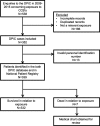Outcomes following calcium channel blocker exposures reported to a poison information center
- PMID: 30482251
- PMCID: PMC6258306
- DOI: 10.1186/s40360-018-0271-9
Outcomes following calcium channel blocker exposures reported to a poison information center
Abstract
Background: Calcium channel blockers (CCBs) are widely used drugs that have a narrow therapeutic index. Even minor overdoses must be treated in-hospital due to the risk of severe hypotension and bradycardia. We aimed to describe trends in CCB use and overdoses in Denmark.
Methods: Data on enquiries concerning CCBs reported to the Danish Poisons Information Center (DPIC) from January 2009 to January 2015 was coupled with data on hospitalization and mortality obtained from Danish National Registers. We obtained data on the general use of CCBs in Denmark and retrieved medical charts on fatal cases.
Results: From a total of 126,987 enquiries to the DPIC in 2009-2014 we identified 339 CCB unique exposures (3‰ of all). Children < 5 years accounted for 20% all exposures and these were classified as 'intake during playing' (61%) and 'medication errors' (39%). Among adults 'suicidal poisonings' (58%), and 'medication errors' (34%) were most frequent. A majority (81%) of exposures led to hospital admission. Seven patients (2%) died from the CCB exposure and all were adults with 'suicidal poisoning'. Amlodipine accounted for 95% of all CCB prescriptions, was involved in 71% of enquiries and in 29% of fatalities. Verapamil accounted for 3% of prescriptions, was involved in 13% of enquiries and 57% of fatalities.
Conclusion: Four fifths of enquiries to the DPIC result in hospitalization and one fifth concern small children. Mortality were infrequent and occurred only in adults with suicidal exposures and with and an overrepresentation of verapamil exposures.
Keywords: Amlodipin; Calcium antagonist; Calcium channel blockers; Diltiazem; Felodipin; Isradipin; Lacidipin; Lercanidipin; Nifedipin; Nimodipin; Nitrendipin; Overdose; Poisoning; Verapamil.
Conflict of interest statement
Ethics approval and consent to participate
The study was approved by the Danish Data Protection Agency (2012-58-0004). In Denmark, the Act on Processing of Personal Data does not require obtained consent or ethical approval for anonymized retrospective registry studies. The Danish Patient Safety Authority approved (journal number 3–3013-1382/1) the retrieval of data from the DPIC database and from the local clinical departments, who forwarded then forwarded the clinical data from medical charts on non-anonymous poisoned patients.
Consent for publication
Not applicable. In Denmark, the Act on Processing of Personal Data does not require obtained consent or ethical approval for anonymized retrospective registry studies.
Competing interests
The authors declare that they have no competing interests.
Publisher’s Note
Springer Nature remains neutral with regard to jurisdictional claims in published maps and institutional affiliations.
Figures




References
-
- Olson Kent R., Erdman Andrew R., Woolf Alan D., Scharman Elizabeth J., Christianson Gwenn, Caravati E. Martin, Wax Paul M., Booze Lisa L., Manoguerra Anthony S., Keyes Daniel C., Chyka Peter A., Troutman William G. Calcium Channel Blocker Ingestion: An Evidence-Based Consensus Guideline for Out-of-Hospital Management. Clinical Toxicology. 2005;43(7):797–822. doi: 10.1080/15563650500357404. - DOI - PubMed
-
- Hoffman RS, Howland MA, Lewin NA, Nelson L, Goldfrank LR, Flomenbaum N, redaktører. Goldfrank’s toxicologic emergencies. Tenth edition. New York: McGraw-hill Education; 2015. 1882 s.
-
- Levine Michael, Boyer Edward W., Pozner Charles N., Geib Ann-Jeannette, Thomsen Todd, Mick Nathan, Thomas Stephen H. Assessment of hyperglycemia after calcium channel blocker overdoses involving diltiazem or verapamil*. Critical Care Medicine. 2007;35(9):2071–2075. doi: 10.1097/01.CCM.0000278916.04569.23. - DOI - PubMed
MeSH terms
Substances
LinkOut - more resources
Full Text Sources

